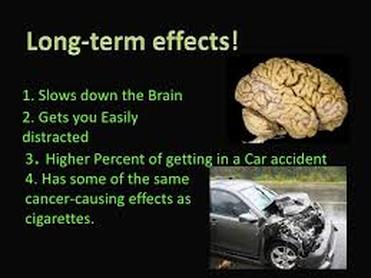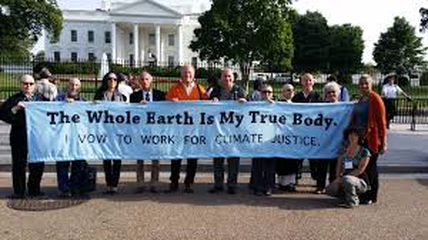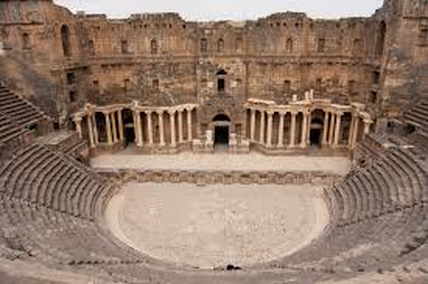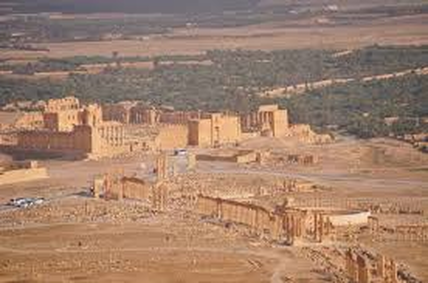 Booksellers celebrated the inaugural Independent Bookstore Day on May 2, 2015, with author events, discounts and giveaways, tasty treats, and special literary-themed merchandise available exclusively at 400 bookstores across the country. “Overall, the day was a great one,” said Samantha Schoech, Independent Bookstore Day’s program director. “And, of course, we learned a lot about how to proceed for next year.” Early results from a survey of the participating stores showed solid sales gains, with 80 percent of the responding stores reporting a sales increase over the first Saturday of May 2014, reported on the ABA website. Are digital or hardcopy books better? The answer many are eager to learn is whether a digital book is better than a printed book? The research is not definitive but provides some insight into the benefits of reading as a total emotional and physical experience. Maryanne Wolf, professor at Tufts University and author of “Proust and the Squid: The Story and Science of the Reading Brain,” says “We are not only what we read but how we read.” Wolf studies the cognitive process of reading, and she thought she was immune to the pitfalls that she cataloged in others, but discovered her assumptions were wrong. Wolf found that her brain was physically altered from the scanning and flitting type of reading she performed during the day, which was different from immersion reading one experiences while reading a novel for example. Her ability to concentrate for longer periods of time was compromised, and she had to read passages over and over to comprehend. It took her two full weeks to regain the sort of immersive reading experience she once enjoyed. "For me the great lesson was that what we do during the day bleeds over into what we do during the night," she says. "The immersion online is always in some ways shadowed, if you will, by this constant reminder that we should be doing something else, too; that our email is just a click away; that there is this almost incessant feeling of 'Well, I should go faster,' instead of 'I should immerse myself.' " Another seemingly unlikely advocate for hard copy books is David Gelernter, a professor of computer science at Yale University. He is a pioneer in advancing “parallel computation,” but he admires the design of codex. “It’s an inspiration of the very first order. …It’s made to fit human hands and human eyes and human laps in the way that computers are not.” When pondering why the rush to cast aside the printed book that has endured for centuries he said, “It’s not as if books have lost an argument. The problem is there hasn’t been an argument. Technology always gets free pass. People take it for granted that if the technology is new it must be better,” he related to NPR. This writer enjoys the best of both worlds, and the statistics show readers also want the convenience and low cost of digital books as well as the romance and sensory adventure of visiting an independent book store in person or online. Nothing can replace the anticipation of either visiting the used book store with its old volumes containing musty slightly yellowing pages or waiting for the book to arrive in the mail from a tried and true online used book store like alibris.com in the US or Charing Cross Road Books in London. Visit ten best independent book stores in the UK listed in The Guardian here. Resources http://www.npr.org/2015/05/28/408787099/the-technology-of-books-has-changed-but-bookstores-are-hanging-in http://www.bookweb.org/
3 Comments
 In a study of 1,882 motor vehicle deaths, the U.S. Department of Transportation found an increased accident risk of 0.7 for cannabis use, 7.4 for alcohol use, and 8.4 for cannabis and alcohol use combined. The National Highway and Traffic Safety Administration (NHTSA) released a study in February 2015 that showed the prevalence of alcohol use by drivers has dropped over the years since the first survey in 1973. They found that 8 percent of drivers during weekend, nighttime hours had alcohol in their system, and 1 percent were found with 0.08 percent of higher breath alcohol content, which is the legal limit in every state. They say, however, that even as drinking and driving continues to fall, use of illegal drugs or medicines that can affect road safety is climbing. The number of weekend nighttime drivers with evidence of drugs in their system climbed from 16.3 percent in 2007 to 20 percent in 2014. The number of drivers with marijuana in their system grew by nearly 50 percent. “A second survey, the largest of its kind ever conducted, assessed whether marijuana use by drivers is associated with greater risk of crashes. The survey found that marijuana users are more likely to be involved in accidents, but that the increased risk may be due in part because marijuana users are more likely to be in groups at higher risk of crashes. In particular, marijuana users are more likely to be young men – a group already at high risk,” in the NHTSA report. “Drivers should never get behind the wheel impaired, and we know that marijuana impairs judgment, reaction times and awareness,” said Jeff Michael, NHTSA’s associate administrator for research and program development. “These findings highlight the importance of research to better understand how marijuana use affects drivers so states and communities can craft the best safety policies.” The AACC study together with the NHTSA evidence of increased use of illegal drugs, marijuana, and medicines when driving warrant more education on risks of combining drugs and alcohol then getting behind the wheel of vehicle. The combination of drugs and alcohol has been a deadly mix for many, but even non-deadly use by individuals puts everyone at risk when they make the decision to drive under the influence.
 A network of Roman Catholics around the globe from the US to the Philippines will be ready to support the teaching document due to be released in the next few weeks including prayer vigils, pilgrimages, policy briefings, seminars and a multitude of sermons supporting the Pope’s directive. Catholic environmental specialists and advocates have been preparing for months to inactive and support the Pope’s directive. For Catholics and those influenced by the church the document is expected to be transformative in the fight against global warming, according to a report in USA Today. Pope to visit the United States and speak on climate change The Pope will be visiting the US in September, and he will be speaking before the UN General Assembly on Sept. 25 about climate change before going to Philadelphia to attend The World Meeting of Families. Environmental advocates want a binding, comprehensive agreement among nations to slow global warming, which is confirmed by the majority of climate scientists who say climate change is driven by carbon emissions. "People are really putting a lot of weight on this," said Nancy Tuchman, director of the Institute of Environmental Sustainability at Loyola University Chicago. "I think the real hope is that he says it like it is and tells us there has to be a call to action and it has to be immediate,” reported in USA Today. Catholic advocates have been working to unite 28 US Jesuit colleges and universities as a common voice on climate change, plans to collect papers from students, faculty and staff with their reflections on the document and how they can be "one of its champions," Tuchman said. A school colloquium on the papers is planned for Sept. 9, they said. Interfaith Summit on Climate Change coordinates with Pope’s visit The Union Theological Seminary in New York City will be the location for an inter-faith summit on climate change Sept. 21-27, 2015. Since Pope Francis will be speaking on the 25th to the UN General Assembly, there are no reports he will make an appearance at this summit. This free event is part of the Interfaith Summit on Climate Change, hosted by both the World Council of Churches and Religions for Peace. For more information and for a program of events, visit interfaithclimate.org. A round-table discussion with Christiana Figueres, Executive Secretary of the United Nations Framework Convention on Climate Change (UNFCCC) will take place. Afterwards, the leaders of the world's religions will sign a historic document on climate change that they will later present to the Secretary General of the United Nations, Ban ki Moon. Buddhist Declaration on climate change The Buddha has made it abundantly clear that nature should be not be interfered with so that humanity may enjoy its presence and value for their benefit. He also taught that all life, including plant life should not be destroyed. Nature is a life giver for humanity, and few elements compromise this philosophy more that man-made climate change. In the spirit of Buddhist tradition on May 15, 2015 the streets of Washington DC were lined with blossoms and greenery for the first “White House—US Buddhist Leadership Conference. One hundred thirty Buddhist teachers, monks, nuns, laymen and laywomen, academics, and organizers met to voice concern on climate change. The subject at hand was called“Voices in the Square—Action in the World.” On May 14, 2015 in coordination with a Buddhist trip to Washington D.C., an official declaration was issued acknowledging climate change using YaleUniversity.edu. The scientific consensus is overwhelming: human activity is triggering environmental breakdown on a planetary scale. Global warming, in particular, is happening much faster than previously predicted, most obviously at the North Pole. For hundreds of thousands of years, the Arctic Ocean has been covered by an area of sea-ice as large as Australia—but now this is melting rapidly. In 2007 the Intergovernmental Panel on Climate Change (IPCC) forecast that the Arctic might be free of summer sea ice by 2100. The Buddhist statement cited Dr. James Hansen of NASA in agreement with other climatologists who have defined precise targets as safe levels of carbon dioxide in the atmosphere as no more than 350 parts per million (ppm), a target endorsed by His Holiness The Dalai Lama together with other Nobel laureates and scientists. The level now is 387 ppm and has been rising 2 ppm per year. The signatories to the declaration join the Dalai Lama to call for a reduction in ppm but also a removal of large quantities of carbon gas. Buddhist teachings accept individual and collective responsibility to meet the 350ppm target, which includes personal and social responses. The window of opportunity is closing and the “tipping point” is near; therefore, we must take action to preserve humanity from imminent disaster and survival of our species. As Buddhists we share the biosphere with many diverse life forms, and the survival and health of the planet for all sentient beings relies on the leadership and guidance of all faiths through compassion and wisdom to confront climate change as real and a result of human behavior. Resources http://www.rawstory.com/2015/05/pope-francis-protecting-the-earth-is-a-requirement-of-christianity/ http://www.usatoday.com/story/news/nation-now/2015/05/24/catholics-sierra-club-pope-francis-climate-change/27896225/ http://www.worldmeeting2015.org/papal-visit/ http://fore.yale.edu/files/Buddhist_Climate_Change_Statement_5-14-15.pdf
The world is watching to see if the Roman ruins will be spared or decimated like other ancient ruins in the path of ISIS as they attempt to erase all vestiges of human civilization before their skewed definition of the beginning of Islam.
Similar to ethnic cleansing, ISIS wants to remove the historical roots from which a people emerged. “In order to dictate the future, ISIS is destroying the past,” reported in an op-ed by Haaretz. “The archaeological sites it destroys are from the Babylonian, Persian and Roman Empires. These eras represent a pluralistic past that legitimizes the presence of Chaldeans, Yazidis and other minorities in the region, with whom ISIS does not share a human heritage. ISIS' interpretation of history maintains that there are two historical eras: Jahiliyah (the time of ignorance) and, the later era, Islam (the time of enlightenment). The presence of sites from the Babylonian, Persian and Roman Empires harks back to a golden age before Islam. ISIS is thus working to erase any trace of those eras, for it thinks it cannot control the future until it controls the past,” they said. Vice president for research at the Foundation for Defense of Democracies Jonathan Schanzer, told Business Insider that ISIS gets most of its money from racketeering, including collection of "taxes" from the residents who live within the borders of the territory it has taken over, plundering people's homes, and looting historical sites and selling antiquities on the black market. "It’s a racket. And that’s how ISIS continues to survive and thrive," Schanzer said. "They need to jump from community to community in order to sustain themselves financially,” according to Business Insider. Looting as propaganda ISIS has proven to be shrewd at using social media and world news reporting to release propaganda videos of militants destroying ancient sites to insight potential converts to their cause and attract recruits and get media attention from the shock value of the destruction. Much of the media coverage surrounding the seizure of Palmyra focused on the fact that a UNESCO World Heritage Site was now in danger. Half of Syria is controlled by ISIS since the invasion of Palmyra. And while the world mourns the loss of lives attributed to the terrorist group, the world also grieves the decimation of historical sites as symbols of our civilization that future generations will only know from pictures. Check out http://www.kaemena360.com/home/360o-city-tours/palmyra-syria.html Mail Online - The slaughter of Palmyra's citizens begins: First images emerge from Syrian city over-run by ISIS... and show rows of people beheaded as terror group celebrates freeing Islamists from state prison Resources http://www.aljazeera.com/news/2015/05/syria-palmyra-unesco-isil-150522060557151.html http://www.businessinsider.com/isis-will-make-money-from-antiquities-in-palmyra-syria-2015-5 http://www.huffingtonpost.com/2015/05/21/syria-palmyra-isis_n_7349194.html?ir=WorldPost http://www.haaretz.com/opinion/.premium-1.646517 Hudziak’s hypothesis states playing the violin could help child battle psychological disorders better than medication.
"We treat things that result from negative things, but we never try to use positive things as treatment," he says. The American Psychological Association has embraced music therapy, but do not imply it replaces medication in a 2013 article called “Music as Medicine.” Music therapy lowered the parents' stress, says Joanne Loewy, the study's lead author, director of the Armstrong center and co-editor of the journal Music and Medicine. "There's just something about music — particularly live music — that excites and activates the body," says Loewy, whose work is part of a growing movement of music therapists and psychologists who are investigating the use of music in medicine to help patients dealing with pain, depression and possibly even Alzheimer's disease. "Music very much has a way of enhancing quality of life and can, in addition, promote recovery." If Hudziak is going to rely on music programs in public education, there are encumbrances because music programs have all but disappeared. According to the study's authors, research from the U.S. Department of Education indicates that three-quarters of U.S. high school students "rarely or never" take extracurricular lessons in music or the arts. Music lessons disappearing from public education The Dept. of Education statistic is disturbing, but not surprising, as funding sources for music; sports; and the arts have slowly diminished as revenue streams for so-called “extracurricular” school programs have been eliminated beginning in the late 1980s into the 1990s and exacerbated by The No Child Left Behind Act (NCLB), which impacted low-income children disproportionately whose parents could not afford private music lessons. Historically elementary schools offered free music lessons to students, so they could explore playing musical instruments and discover what they liked. This writer’s son was able to take drum music lessons in elementary school in the 1980s, which he continued throughout junior high and high school and enriched his adult life. Those music programs together with the school library have been gone for many years. Today the NCLB is uniformly blamed for stripping curriculum opportunities, including art, music, physical education and more, and imposing a brutal testing regime that has forced educators to focus their time and energy on preparing for tests in a narrow range of subjects: namely, English/language arts and math. For students in low-income communities, the impact has been devastating as families struggle just to get through the Great Recession. Once those programs have been eliminated, it is even more difficult to financially reinstate them. Music lessons in schools and low-income families are considered an added benefit if funding sources and expenses allow it. Studies like Dr. Hudziak’s contribute to a body of evidence that early childhood music lessons have benefits far beyond childhood and should be considered when public schools evaluate budgets. "Such statistics, when taken in the context of our present neuroimaging results," the Vermont College researchers write, "underscore the vital importance of finding new and innovative ways to make music training more widely available to youths, beginning in childhood.” Resources http://www.sciencedaily.com/releases/2014/12/141223132546.htm http://www.apa.org/monitor/2013/11/music.aspx http://neatoday.org/2014/09/02/the-testing-obsession-and-the-disappearing-curriculum-2/  A recent New York Times article by Matt Apuzzo reported that in the Obama era, “police departments have received tens of thousands of machine guns; nearly 200,000 ammunition magazines; thousands of pieces of camouflage and night-vision equipment; and hundreds of silencers, armored cars and aircraft.” Police agencies around the nation possess military-grade equipment, turning officers who are supposed to fight crime and protect communities into what appears to be an invading army. And military-style police raids have increased in recent years, with one count putting the number at 80,000 such raids last year. Certainly no one realized at the time that when these donations began, they would result in an evolving police state pitting Americans against paramilitary-style police departments, particularly departments not trained properly. American communities are not battle fields, and American citizens are not the enemy. In response to the public outcry about the militarization of police departments, President Obama has issued a ban on the US government from supplying certain types of military-style equipment to local police departments, as well as control of other weapons and gear supplied to law enforcement, according to a report in The Guardian. The President’s announcement is in coordination with a 116-page report recommending an even broader taskforce on criminal justice reform, alongside several proposals for local agencies around the US focused on how police can build trust in communities, especially those disproportionately affected by crime, they said. The report calls on police to “embrace a guardian – rather than a warrior – mindset to build trust and legitimacy both within agencies and with the public.” How the United States became a police state In June 2014, the American Civil Liberties Union (ACLU) brought more attention to police militarization when it issued a comprehensive, nearly 100-page report titled, War Comes Home: The Excessive Militarization of American Policing. Based on public records requests to more than 260 law enforcement agencies in 26 states, the ACLU concluded that this police militarization “unfairly impacts people of color and undermines individual liberties, and it has been allowed to happen in the absence of any meaningful public discussion,” according to Bill Moyers website. The ACLU reports 11 ways the militarization of police has impacted US Society. 1. Harms and kills innocent people 2. Children are impacted 3. The use of SWAT teams is often unnecessary 4. The “war on terror” is fueling militarization 5. It’s a boon to contractor profits 6. Border militarization and police militarization go hand in hand 7. Police are cracking down on dissent 8. Asset Forfeitures are funding police militarization 9. Dubious informants are used for raids 10. There has been little debate or oversight 11. Communities of color bear the brunt For a complete description of each of the above visit the link to Bill Moyers website. Finally, US police departments are not the only entity to gradually become more violent and militarized, for American society has become increasingly violent as each generation becomes desensitized to violence which is evidenced by the perceived need to possess military-style weapons, entertainment choices, romanticizing and encouraging violence beginning in childhood with toys that imprint on young minds that violence is how to problem solve. The incongruity is clear when we hear consistently crime is down in most cities, yet the incarceration rate in the US is the highest of any country in the world at 716 per 100,000 population as of 2013. These numbers reflect a multitude of problems with the American justice system including the criminalization of drug addiction, but the proliferation of weapons and a “weaponized society” are at the core. We applaud President Obama for risking criticism from some entities by pulling back on supplying paramilitary-style weaponry to police agencies. This is a start to not only de-militarizing police departments, but also sets a tone for the nation pivoting towards community policing incorporating methodologies of engagement that defuse and mitigate, rather than inflame and escalate. If the federal government wants to be a partner in change, then it should provide funding for education and training to transform policing in communities. Under the community policing model officers are empowered to identify and solve problems proactively involving a blend of skills: 1) develop community partnerships; 2) engage in problem solving; 3) implement community policing organizational features like using technology to solve crimes and management, recruitment, hiring, and training; 4) reward policing agencies for innovation and creative solutions to keeping the peace using peaceful means. Resources http://www.theguardian.com/us-news/2015/may/18/president-obama-limits-supply-military-style-equipment-police?CMP=ema_565 http://www.nbcnews.com/news/us-news/u-s-cracking-down-militarization-local-police-n360381 http://billmoyers.com/2014/08/13/not-just-ferguson-11-eye-opening-facts-about-americas-militarized-police-forces/ http://discoverpolicing.org/whats_like/community-policing/
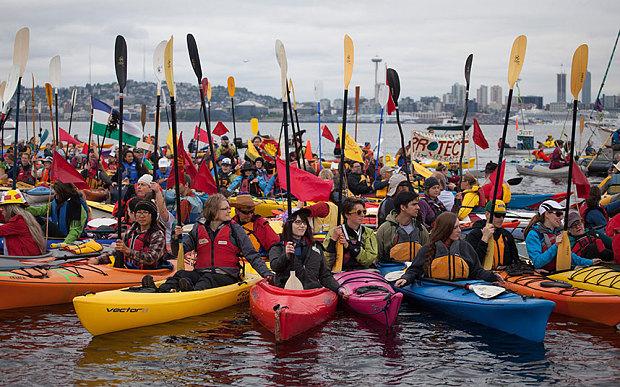 This is the same oil rig that Greenpeace protesters occupied by boarding the vessel in April. The occupiers came from six countries around the world — Germany, New Zealand, Australia, Sweden, Austria and the U.S. boarded the rig about 750 miles northwest of Hawaii. Back in April the group said they intended to stay “as long as it takes for Shell to get our message loud and clear that drilling in the Arctic is entirely unacceptable,” according to the Seattle Times. Aliyah, Jens, Zoe, Andreas, Miriam and Johno of Greenpeace scaled and occupied the Polar Pioneer oil drilling rig to bring attention to saving the Arctic as pristine wilderness and not just another oil field to be plundered. The six activists sped beside the rig aboard an inflatable raft, and then casted climbing lines to get aboard. They created a camp with tarps and hammocks on the tiny catwalk under the main deck. Unfortunately, the activists were forced to leave the protest in April after six days due to reports of seven-metre swells and extreme weather coming their way. Although their occupation is over, Widlund and Buckley Lennox plan to travel to Seattle for the festival of resistance. “I really care about these issues and I want to do whatever I can to keep it going,” Buckley Lennox said in the Times Colonist. The kayakers have been part of the ongoing protest at every port voicing opposition to oil drilling in the Chukchi Sea in Alaska. The Shell oil vessels have travelled across the Pacific from Malaysia. While the Greenpeace ship Esperanza docked in Victoria, Washington the Shell vessel was greeted by about three dozen protesters in kayaks in Port Angeles. The Polar Pioneer was to be off-loaded in Port Angeles, Washington to have equipment installed. The rig then traveled to Seattle for further staging, before it’s expected to head north and begin exploratory drilling in the Chukchi Sea. Eric Ross of Shell No Action Coalition says kayakers are training for a “festival of resistance” in Seattle on May 16-18, during which a flotilla of kayaks will gather around the vessel. Greenpeace’s goal with the occupation and demonstrations at every port where the oil rig plans a stay is to spread awareness about offshore drilling in the Arctic, which it says poses an unnecessary risk to the environment. Pacific Northwest rejects ports as gateway for crude oil exports Environmental groups in the Pacific Northwest are spearheading a shift in the politics that surround energy production and have mobilized against a series of projects that would transform the region into a gateway for crude oil and coal exports to Asia. "These proposals have woken a sleeping giant in the Northwest," said Eric de Place, policy director for Sightline Institute, a liberal Seattle think tank. "It has unleashed this very robust opposition movement, “ in USA Today. In addition, Seattle City Councilmember Mike O'Brien, who joined the so-called kayaktivists on the water Thursday: "Shell's attempt to use Seattle as a home base for Arctic drilling may be the last battle on the front of Arctic drilling, and the energy I have seen and felt from people in the region is really powerful and it gives me hope that we can stop Arctic drilling." All has not gone well for Shell Shell's last effort to do exploratory drilling in the Arctic Ocean also stopped off in Seattle, but the trip for rig ended badly. The Noble Discoverer and the Kulluk was a rig Shell had spent hundreds of millions of dollars to customize became stranded by equipment failures in stormy weather, and the Coast Guard barely rescued the Kulluk's crew. Federal investigations resulted in guilty pleas and fines for rig owner Noble Drilling. The Kulluk ended up on a scrap heap in China. The fight to save the Arctic from oil drilling is really just beginning as on Monday the federal US Bureau of Ocean Energy Management, after taking public comments and reviewing voluminous reports, approved the multiyear oil exploration plan. If exploratory drilling goes well, unlike the The Kulluk fiasco, Shell intends to invest billions more in infrastructure to open a new oil frontier, building pipelines under the ocean and onto the tundra of Alaska's North Slope, along with roads, air strips and other facilities. Expect more demonstrations and protests as Shell continues its quest to drill for oil in Alaska, and activists from around the world demonstrate opposition. Related: Greenpeace Save the Arctic protest Resources http://www.usatoday.com/story/money/business/2015/05/14/offshore-oil-rig/27303559/ http://www.timescolonist.com/news/local/oil-rig-occupiers-docked-at-ogden-point-are-keen-for-next-protest-1.1827912\ http://www.usnews.com/news/us/articles/2015/05/15/kayakers-protest-as-arctic-drill-rig-moors-off-seattle |
Dava Castillo
is retired and lives in Clearlake, California. She has three grown
children and one grandson and a Bachelor’s degree in Health Services
Administration from St. Mary’s College in Moraga California. On the
home front Dava enjoys time with her family, reading, gardening, cooking
and sewing. Archives
November 2015
|

